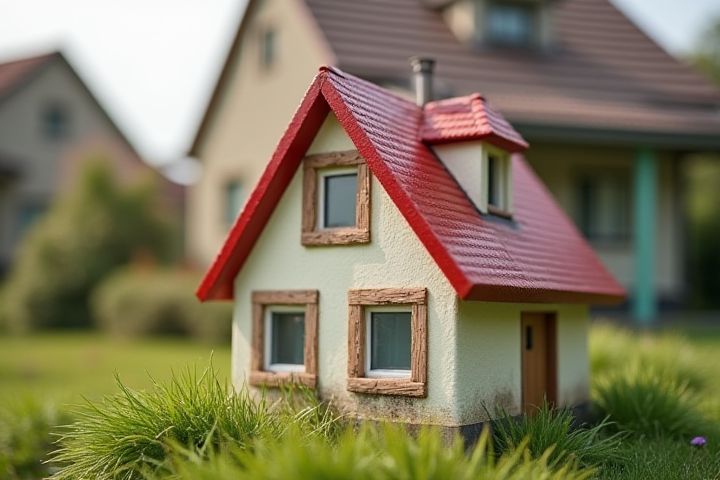
House insurance rates vary due to several factors that influence the perceived risk associated with insuring a property. Location plays a crucial role, with areas prone to natural disasters like floods, hurricanes, or wildfires typically facing higher premiums. The age and condition of your home also significantly impact rates, as older homes may have outdated electrical or plumbing systems that increase risk. The home's construction materials can affect susceptibility to damage, where brick or stone homes might have lower rates compared to wood-framed houses. Lastly, your credit score can influence insurance rates, as insurers often view it as an indicator of financial responsibility.
Why House Insurance Rates Vary
Location
House insurance rates significantly vary based on location due to multiple risk factors associated with specific areas. Regions prone to natural disasters, such as hurricanes or earthquakes, typically see higher premiums as insurers account for potential property damage. Urban locations often experience increased theft rates, prompting higher costs to cover the risk of burglary and vandalism. Furthermore, proximity to fire stations, crime rates, and even the local economy can influence your insurance rates, underscoring the importance of understanding your geographical context when evaluating house insurance options.
Home age and condition
Home age significantly impacts house insurance rates, as older homes often present increased risks due to outdated electrical systems, plumbing issues, and structural vulnerabilities. The condition of your home also plays a crucial role; well-maintained properties usually attract lower premiums, while those in disrepair can lead to higher rates due to higher likelihood of claims. Insurers often assess these factors through detailed inspections and reports to determine the overall risk associated with insuring your property. Investing in regular maintenance and upgrades can reduce your premiums and ensure your home remains insurable.
Replacement cost
House insurance rates vary significantly due to the replacement cost, which is the amount needed to rebuild your home in the event of damage or destruction. Factors such as local construction costs, labor availability, and the materials used in your home's structure can influence this estimate. For example, if your home is built with high-end materials or is located in an area with rising construction expenses, your replacement cost--and therefore your insurance premium--will be higher. Understanding the replacement cost is crucial for ensuring you have adequate coverage that reflects the true value of your home in the event of a claim.
Construction materials
Construction materials significantly impact house insurance rates due to their varying levels of durability, fire resistance, and susceptibility to natural disasters. Homes built with sturdy materials like brick or concrete typically attract lower premiums, as they provide greater protection against structural damage. In contrast, houses made from wood may incur higher insurance costs due to their increased risk of fire and pest infestation. When investing in home insurance, consider how the choice of construction materials can affect your overall premium and coverage options.
Claim history
Claim history significantly impacts house insurance rates, as insurers assess risk based on your past claims. Homeowners with multiple claims in the last five years may encounter premiums that are 20% to 50% higher than those with clean records. Each claim can indicate potential risks, prompting insurers to adjust rates to mitigate potential losses. By maintaining a low claim history, you can potentially save hundreds annually on insurance costs.
Deductible amount
House insurance rates significantly vary based on the deductible amount you choose. A higher deductible, such as $2,000, often results in lower monthly premiums, as you're assuming more financial risk before the insurance kicks in. Conversely, selecting a lower deductible, such as $500, typically leads to higher monthly payments because the insurer is taking on more risk. Understanding how deductible amounts impact your overall policy cost can help you make informed decisions about your coverage and budget effectively.
Security features
Home insurance rates significantly fluctuate based on security features implemented in a property. Homes equipped with advanced security systems, including monitored alarms, surveillance cameras, and smart locks, often attract lower premiums due to their reduced risk of burglary and vandalism. According to data, houses with high-quality security systems can see savings of 5% to 20% on their insurance costs. Investing in enhanced security not only protects your property but also offers financial benefits when it comes to insuring your home.
Coverage limits
Coverage limits significantly influence house insurance rates, as higher limits increase the potential payout in the event of a claim. For instance, if you opt for a coverage limit of $300,000 instead of $200,000, your policy premium will likely be higher due to the additional risk taken on by the insurer. This adjustment reflects the property's value, location, and the overall market conditions, impacting your overall insurance cost. Understanding the balance between adequate coverage and affordability is crucial for managing your insurance expenses effectively.
Local crime rates
Local crime rates significantly influence house insurance rates, as insurers assess risk levels based on the likelihood of theft, vandalism, and other criminal activities. For instance, neighborhoods with higher crime rates may see insurance premiums increase by 20% to 50% compared to safer areas. In contrast, low-crime regions tend to enjoy lower rates, reflecting their reduced risk profile. You can benefit from understanding your locality's crime statistics to better evaluate your insurance costs and seek appropriate coverage.
Personal credit score
Personal credit scores significantly impact house insurance rates, as insurers assess statistical correlations between creditworthiness and the likelihood of filing claims. A higher credit score typically indicates responsible financial behavior, which can lead to lower premiums, while lower scores may signal higher risk of non-payment and frequent claims. Insurers use this data to develop risk assessment models, influencing your premium costs. Consequently, maintaining a good credit score can help you secure more favorable insurance rates and save on overall expenses.
